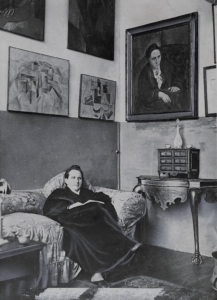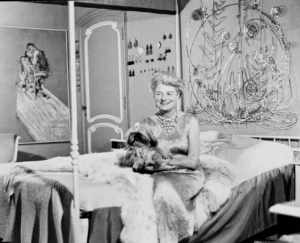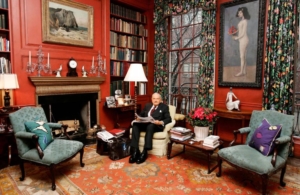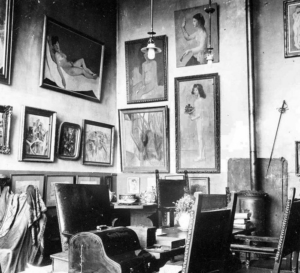The reasons people collect art are as diverse as the collections themselves. Some are passionate about the work of a particular artist or genre; others are collectors of works on paper, or perhaps miniatures; others specialise in a particular subject, and pursue that interest across categories and periods. The provenance of an object or artwork, and its history in a significant collection, can add considerably to its value, interest and appeal. Head of Research Dr. Molly Dorkin took a closer look at some of the 20th century’s most influential – and memorable – collectors in the summer term of our zoom master class series, and in this insight we turn the spotlight on a few favourites.


Gertrude Stein at 27 Rue de Fleurus, Paris, with her 1905-06 portrait by Pablo Picasso, today at the Metropolitan Museum of Art, New York
California-raised siblings Leo and Gertrude Stein transformed a relatively modest budget into a legendary collection, thanks to a combination of excellent taste, fortuitous timing, and the advice of influential dealers like Ambroise Vollard – who once said of the duo ‘The Steins were my only clients who collected, not because they were rich, but despite the fact that they weren’t.’ After being priced out of the market for Cézanne, the Steins looked to emerging artists, and in 1905 they were the only collectors buying works by both Matisse and Picasso; indeed, they were responsible for introducing the two and sparking one of the 20th century’s great artistic rivalries. Their support and patronage were invaluable to the young, often impoverished artists whose work they bought. After falling out in 1913, the Steins divided their collection, with Leo taking his Renoirs and Matisses off to Florence while Gertrude remained in Paris with her beloved Cubist collection, which was willed to her nephew upon her death in 1946.


Peggy Guggenheim with Alexander Calder’s Silver Bedhead, 1945-46, and Francis Bacon’s Study for Chimpanzee, 1957, both currently at the Peggy Guggenheim Collection, Venice
Heiress Peggy Guggenheim had an advantage the Steins lacked – namely, deep pockets – but shared with them a superb eye for emerging talent and a passion for collecting. Guggenheim spent the inter-War years in Paris, socialising with artists including Man Ray, Marcel Duchamp and Brancusi, and when hostilities broke out she fled to the safety of America – with new husband (and German national) the Surrealist Max Ernst in tow. Guggenheim gave numerous artists important career breaks, among them Kandinsky, Rothko and Pollock (whom she discovered when he was working as a carpenter in her uncle’s Guggenheim Museum). As notorious for her personal life as she was admired for her patronage – once, when asked how many husbands she had had, Guggenheim replied ‘you mean my own, or other people’s?’ – Peggy Guggenheim spent her final years at the Palazzo Venier dei Leoni in Venice, travelling around La Serenissima by private gondola. She bequeathed her palazzo, and the collection it contained, to the Solomon R. Guggenheim Foundation as a museum.


David Rockefeller with Pablo Picasso’s Young Girl with a Flower Basket, 1903, on his left
The Stein legacy continued in 1968 when her nephew’s children decided to offer it for sale and it caught the eye of another of the 20th century’s most important collectors: David Rockefeller. David was the son of John D. Rockefeller, Jr. and his wife Abby Aldrich Rockefeller, themselves lifelong collectors and philanthropists. David had inherited his mother’s position on the board at MoMA, the museum she co-founded in 1929, and when the Stein collection came on the market, he spearheaded a syndicate seeking to purchase it. After the museum received certain pieces, David and his fellow patrons divided the remainder, and among the trophies he and his wife Peggy took home were Picasso’s Young Girl with a Flower Basket (1903), for which he paid just under $1 million – it had cost the Steins just £30 in 1905. When David, who outlived Peggy, died in 2017 aged 101, the couple’s 1500-object collection (which featured both bought and inherited works spanning Impressionism, American art, English and European Decorative art, Chinese, Japanese, Korean and European porcelain, and Folk art) was consigned to auction. It achieved over $835 million, the highest-ever total for a single-owner sale, on behalf of charities including MoMA and Harvard University. The Picasso Young Girl with a Flower Basket went to a private collector for just over $115 million.


Gertrude Stein’s Paris apartment with part of her collection, including Pablo Picasso’s Young Girl with a Flower Basket, 1903
To hear more about these and other collectors, you can watch the video of Molly’s talk on Great Collectors of the 20th Century here. We will be bringing you more stories of notable collectors, from the Renaissance to today, in a series of social media posts on this topic.


